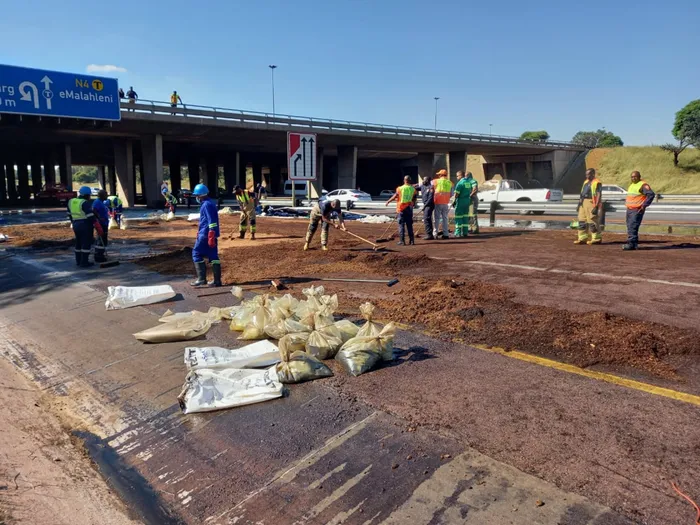Zambia's Toxic Spill: South African firm uncovers a geopolitical scandal
Opinion

Specialist contractors from Drizit Spill Technologies, Oil and Chemical Pollution Control eradicate an oil spill at the N1/N4 intersection.
Image: James Mahlokwane
A SOUTH African environmental firm, Drizit Environmental Services, has uncovered a toxic scandal in Zambia's Copperbelt, exposing a cover-up of an acid spill that has the potential to poison millions of Zambians.
The story, first brought to international attention by media houses like the BBC, Reuters, and Al Jazeera, began in February 2025 when a tailings dam at the Chinese-owned Sino Metals copper mine in Zambia burst, releasing toxic poison into the Kafue River’s watershed.
According to Human Rights Watch, the dam spewed over 1.5 million tonnes of deadly toxins into the Mwambashi River, which connects to the Kafue River that sustains 12 million Zambians with water.
Initially, Sino Metals avoided addressing the health and environmental concerns and instead turned the crisis into a geopolitical tussle by involving Beijing, which subsequently accused the US of misconduct for whistleblowing.
The pollution, packed with cyanide, arsenic, lead, uranium, and 16 heavy metals exceeding World Health Organisation safety limits, killed fish, burned maize and groundnut crops, and led to the deaths of livestock, wiping out the livelihoods of local farmers and posing a severe risk to residents.
The Zambian government also dismissed warnings of the scale of the disaster despite environmental warnings and downplayed it as a minor leak. Drizit Environmental Services was subsequently hired by Sino Metals to assess the damage, but the South African company quickly became the whistleblower.
Their two-month investigation, involving 3 500 samples across 100 kilometres of river, revealed a spill 30 times larger than the company's claim of 50 000 tonnes. Some 900 000 cubic meters of toxic waste now taints the environment, threatening long-term health effects like cancer, organ failure, and birth defects.
When Drizit presented these findings, Sino Metals fired them in June, branding the report “exaggerated” and refusing to pay them.
The gravity of the situation was also underscored when the US Embassy evacuated staff and dependents from the Copperbelt in August, issuing a security alert warning of “environmental and carcinogenic risks” from the spill. Similarly, the Finnish government and other European embassies warned their citizens in Zambia of the severe health dangers, specifically citing uranium and arsenic levels they deemed unfit for human contact.
These coordinated diplomatic warnings served to scientifically validate the concerns that local communities had been raising for months, and while these foreign governments were taking protective measures for their citizens, the on-the-ground response within Zambia was widely seen as insufficient.
The Zambian air force’s efforts to drop lime into the watershed to neutralise the acidic water were a visible gesture, but experts and observers quickly criticised the operation as being a mere drop in a poisoned bucket, incapable of addressing the monumental scale of the contamination that threatens the region’s ecosystem and groundwater.
But it was the sight of dead fish and livestock piling up, and villagers reporting headaches, skin sores, and diarrhoea from tainted water and soil that turned the story into an international environmental disaster. Drizit in particular did not back down. They self-funded parts of the probe and leaked the report, which forced the Zambian Government to make a U-turn.
In a recent interview, Zambian Vice President Mutale Nalumango vowed that citizen safety is “non-negotiable” and demanded significantly more compensation than the initial offer of $580 000 (R10.1 million). However, for many villagers who were allegedly coerced into accepting meagre $17 payouts, and for the 700 000 residents of Kitwe still facing contaminated water, this commitment comes too late.
This is the fourth mining disaster in the Kafue watershed this year, with Chinese and British firms dumping waste as if Zambian lives do not matter.
This is not just Zambia's tragedy; it is Africa's. Our copper and lithium, from Zambia to Zimbabwe, feed global gigafactories, powering EVs and batteries for the world. In 2023, China alone invested $1.3 billion in Zambian mines, shipping out raw ore while Zambia buys back Chinese finished goods, cars and electronics.
South Africa's, Zimbabwe's lithium mines, and the Congolese mineral trade mirror this disproportionate exchange: extracted cheaply in Africa, processed abroad, and sold back to Africa as batteries, cars, and solar panels we cannot afford, all creating generational debt premised on so-called benevolence.
It was only through the efforts of Drizit, which is now suing for unpaid fees, that the full scale of the disaster was exposed, saving countless lives by bringing a crisis that might otherwise have remained hidden into the light.
Furthermore, our nations must fundamentally renegotiate the contracts that govern the extraction of our resources. For too long, raw materials have been shipped out cheaply, only to be processed abroad and sold back to us at a premium as finished goods. This disproportionate exchange traps us in a cycle of dependency and debt, falsely premised as benevolent investment.
New contracts must be designed to retain value within Africa by mandating local beneficiation, technology transfer, and skills development. This ensures that our copper, lithium, and other minerals fuel our own industrialisation and create lasting prosperity for Africans, rather than wealth for foreign shareholders.
* Phapano Phasha is the chairperson of The Centre for Alternative Political and Economic Thought.
** The views expressed here do not reflect those of the Sunday Independent, IOL, or Independent Media.